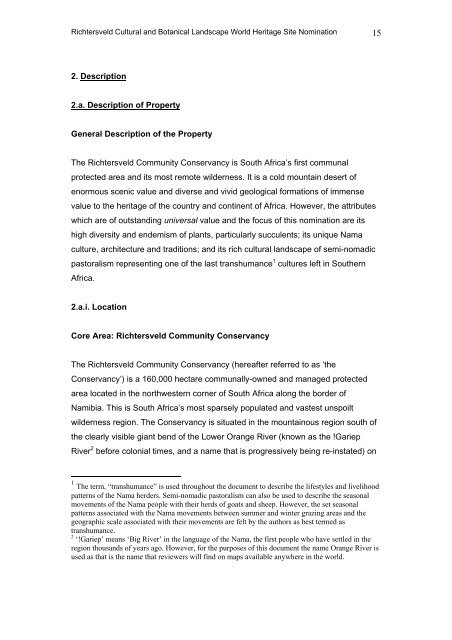the richtersveld cultural and botanical landscape - SAHRA
the richtersveld cultural and botanical landscape - SAHRA
the richtersveld cultural and botanical landscape - SAHRA
You also want an ePaper? Increase the reach of your titles
YUMPU automatically turns print PDFs into web optimized ePapers that Google loves.
Richtersveld Cultural <strong>and</strong> Botanical L<strong>and</strong>scape World Heritage Site Nomination 15<br />
2. Description<br />
2.a. Description of Property<br />
General Description of <strong>the</strong> Property<br />
The Richtersveld Community Conservancy is South Africa’s first communal<br />
protected area <strong>and</strong> its most remote wilderness. It is a cold mountain desert of<br />
enormous scenic value <strong>and</strong> diverse <strong>and</strong> vivid geological formations of immense<br />
value to <strong>the</strong> heritage of <strong>the</strong> country <strong>and</strong> continent of Africa. However, <strong>the</strong> attributes<br />
which are of outst<strong>and</strong>ing universal value <strong>and</strong> <strong>the</strong> focus of this nomination are its<br />
high diversity <strong>and</strong> endemism of plants, particularly succulents; its unique Nama<br />
culture, architecture <strong>and</strong> traditions; <strong>and</strong> its rich <strong>cultural</strong> l<strong>and</strong>scape of semi-nomadic<br />
pastoralism representing one of <strong>the</strong> last transhumance 1 cultures left in Sou<strong>the</strong>rn<br />
Africa.<br />
2.a.i. Location<br />
Core Area: Richtersveld Community Conservancy<br />
The Richtersveld Community Conservancy (hereafter referred to as ‘<strong>the</strong><br />
Conservancy’) is a 160,000 hectare communally-owned <strong>and</strong> managed protected<br />
area located in <strong>the</strong> northwestern corner of South Africa along <strong>the</strong> border of<br />
Namibia. This is South Africa’s most sparsely populated <strong>and</strong> vastest unspoilt<br />
wilderness region. The Conservancy is situated in <strong>the</strong> mountainous region south of<br />
<strong>the</strong> clearly visible giant bend of <strong>the</strong> Lower Orange River (known as <strong>the</strong> !Gariep<br />
River 2 before colonial times, <strong>and</strong> a name that is progressively being re-instated) on<br />
1 The term, “transhumance” is used throughout <strong>the</strong> document to describe <strong>the</strong> lifestyles <strong>and</strong> livelihood<br />
patterns of <strong>the</strong> Nama herders. Semi-nomadic pastoralism can also be used to describe <strong>the</strong> seasonal<br />
movements of <strong>the</strong> Nama people with <strong>the</strong>ir herds of goats <strong>and</strong> sheep. However, <strong>the</strong> set seasonal<br />
patterns associated with <strong>the</strong> Nama movements between summer <strong>and</strong> winter grazing areas <strong>and</strong> <strong>the</strong><br />
geographic scale associated with <strong>the</strong>ir movements are felt by <strong>the</strong> authors as best termed as<br />
transhumance.<br />
2 ‘!Gariep’ means ‘Big River’ in <strong>the</strong> language of <strong>the</strong> Nama, <strong>the</strong> first people who have settled in <strong>the</strong><br />
region thous<strong>and</strong>s of years ago. However, for <strong>the</strong> purposes of this document <strong>the</strong> name Orange River is<br />
used as that is <strong>the</strong> name that reviewers will find on maps available anywhere in <strong>the</strong> world.

















